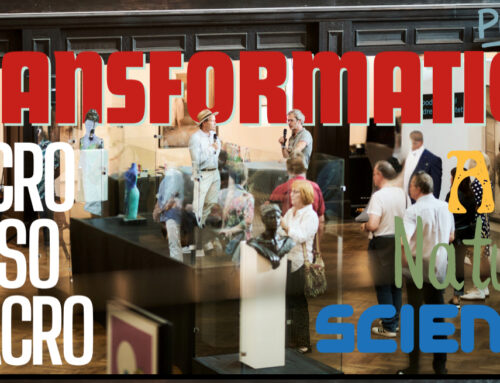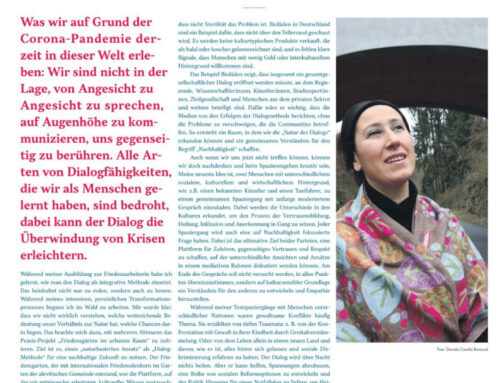Wars happen if there is no investment in sustainability and a culture of peace. And all wars, must end in peace. Unfortunately, we are in a situation today, where peace must be restored again. There is an onus upon all of us to take part in the world’s peaceful, just, and sustainable transformation process, and to take responsibility for future generations. We started to pay attention to “-de” structure structural violence, and made it visible with historical colonization arguments. We started to see the rise of identity-based conflicts, but could not manage to find a third side where people could create dialogue and meet with each other to reduce violence in our cities. At the same time, there were also many warnings about destructive nature-human relations due to climate change. Regrettably, here we have not yet started pre-disaster prevention education programs in our neighborhood’s forums, schools, community spaces, etc, to prepare local citizens for migration flows, floods, and heat waves. And finally, we are all traumatized communities. There has not been enough work to heal ourselves. And yet, we think that walking, cycling, and going to a park — if we can find such a green space and biodiversity in the future — is enough. Bottom line, it means that we are not working hard enough for the “-re” structure of peace at the individual and local level. It also means that we do not have sufficient numbers of New Peacebuilding Approaches, or skilled and educated human resources who can implement science-to-practice methods and new meaningful ideas in the real-world. We need more peace thinkers, intellectuals, academicians, teachers, artists, journalists, and entrepreneurs who can solve a variety of intersectional problems at the same time, rather than just spreading fear, analyzing and sharing horrible facts/news, and criticizing “others.”
I am the initiator of the Peace Garden in Wuppertal, Germany. It is a symbol of transformation, a common future, and peace.
Additionally, there are a lot of ongoing power struggles. Such as knowledge-production processes for innovation, high-tech sustainable energy options, and the provision of clean water between countries, nations, and other diverse groups. And at the same time, we also have the hatred of generations. Which is now spiraling into systematic violence. And systemic violence, is now turning into revenge.
Clearly, new nature-based Peacebuilding models need to be utilized for constructive thinking of new ideas and new approaches. [Note: In fact, these have already been experimented with in such spaces, with the scientific results being quite positive.] One of the reasons for negative resistance and for not taking responsibility for a common future to date, relates to the “how, what, and why” of the language that we use (I will give more details about how to transform it in the following section). Another reason, is that in today’s “unchartered territory”, invalid decisions have been made by our leaders “living in” privileged castles and ivory towers. If all these institutional, political, scientific, artistic, etc efforts were correct in their “expert” guidance, why is violence growing everywhere? For instance, why has my generation (I am 42 years old now) witnessed more than 100 groups actively committed to the Syrian war…with millions now becoming refugees? What has happened to Afghan women after just one day of the Taliban taking back control of this country? How will Iranian solidarity resist radical extremism? Should I even begin to describe here the many horrors seen in Sudan? In Israel-Gaza? In Ukraine? Or, let’s take another example from an ecological perspective: In Russia’s Siberian south, the world’s largest freshwater lake…Lake Baikal…is shrinking. The communities surrounding this lake depend on it for their power, water, and livelihoods. What is their future? We could add thousands of additional questions and examples here. And provide many reasons which could further explain the cause-and-effect relationships and root-cause problems. But these become irrelevant…if Peace Science continues to exchange its ideas and knowledge among closed groups, while not recognizing peace’s real-world local-transformation power and its ability to direct the future. This prevents it from co-operating and collaborating with existing currents of thinking that would contribute to the positive evolution of humanity and nature.
The Power of Peace Language and Its Impacts
We are long overdue in realizing that if people’s behavior and actions continue to contradict their thoughts, they will not be able to find solutions to problems. We are trying to understand a world in which violence is becoming more and more normalized, while “peace” should come naturally from our self-nature and environment. We think work and wearing ourselves out for the continuation of happiness…is sustainable. Our lives have narrowed everything down. We’re closed in on ourselves. This is a natural defense mechanism against what is happening. But unfortunately, it is not a solution in the long run. Wherever we are in the world, we are responsible for transforming, spreading, and implementing peace. Which is a great privilege. But how does one fulfil that privilege when conflicts arise in front of our doors? In a previous seminar I gave on “Promoting the 2030 Sustainable Development Goals at the local level and strengthening the resilience of communities in the transformation process, “I shared my knowledge with a diverse group of local community representatives. There were various participants from different generations, genders, and educational backgrounds. The topic was heavy: How could we take responsibility for having and sharing a good life in this world where we live together? During the seminar, I tried to simplify and use the Language of Peace as a method that could reach such a diverse group. It worked. In this real-world “experiment”, it was possible to reach a diverse group of people…at the same time and same place…with simple, constructive language. Learning the Language of Peace requires effort. It is the part of the formal and informal Peace Education process. Afterwards in the implementation phase, the speed of spread from micro (individual-local) to meso and then on to macro, is now faster. Because of the desire for Peace in today’s communities. And, because individuals today who become a part of Peace processes, get to touch other people’s lives with their constructive thoughts or experiences. Giving everybody agency in the transformation process, while taking responsibility for peace. Local communities today now have the power to change their surroundings, believing that peace is possible. During the seminar, one question was core to the discussion: How can individuals participate? I responded: For a young person, this can be an opportunity to implement an idea for ecological issues (even when there is an ongoing conflict in his/her country). For a mom, it can mean organizing a neighborhood activity amongst diverse cultures. For a scientist, it can be an attempt to create new spaces to support constructive ways of inclusive thinking. For an educator, it can be creating dialogue focused on new nature-based solutions to reduce consumption. And let’s not forget those with grey hair. They not only want to take on the responsibility for the future…but many have the time, health, and flexibility to volunteer.
If you are aware, this New Peacebuilding Method can guide you towards constructive thinking. And using new Peace-Language chosen with relevant sensitivity, can greatly enhance its implementation. We are all responsible for transforming, spreading, and implementing peace. It just starts…with a first step.
BURCU EKE-SCHNEIDER
Burcu Eke-Schneider was born in Ankara, Türkiye. Following her field experiences, she studied Peace and Conflict Studies with a number of the world’s renowned professors. In 2018, Eke-Schneider initiated a local and transformative peacebuilding study in Wuppertal, Germany. Its goal: Find new nature-based solutions for a common future which could be implemented around the world. As a result, the scientific “Wuppertal Urban Gardening Peace Project’s Peace Garden” was initiated. It resulted in a proven solution for a peaceful, just, and sustainable future…by cities, communities, and diverse actors. This original initiative in Wuppertal, has not only become an empirical example for the scientific community, it has now catalyzed new transformative thinking in micro-meso-macro-level science-to-practice methods for implementation of new peacebuilding methods. Eke-Schneider has additionally published many articles, contributed scientific papers, and educated diverse groups in the field.
Featured Image by Berthold Schneider
Second Image by Burcu Eke-Schneider
Third Image by Neslihan Öztürk
***
For the original article and further content please visit https://welt-schau.com/


